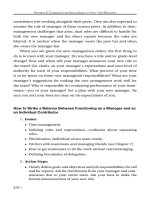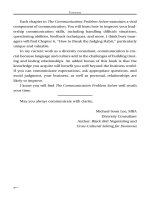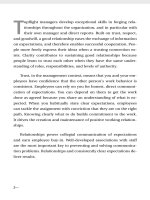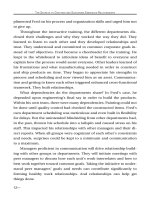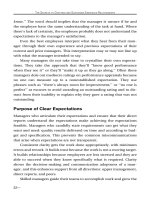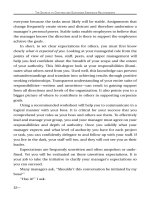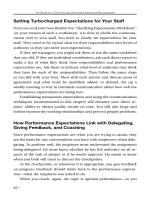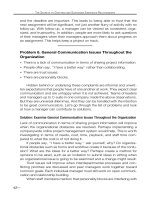The Communication Problem Solver 27 docx
Bạn đang xem bản rút gọn của tài liệu. Xem và tải ngay bản đầy đủ của tài liệu tại đây (81.64 KB, 10 trang )
L
EADING
C
OLLABORATIVE
C
ONVERSATIONS
Comments such as ‘‘Uh-huh,’’ ‘‘Hmmm,’’ ‘‘Yes,’’ ‘‘I see,’’ and ‘‘Oh?’’
said in a neutral, friendly tone of voice are nonjudgmental and noncom-
mittal and encourage the speaker to continue talking. They are indica-
tors that the listener is interested in hearing more detail about this topic.
Employee: ‘‘So accounting has not gotten back to me on that report . . .’’
Manager: ‘‘Oh?’’
Employee: ‘‘No. I guess I had better call them right now to follow up.’’
Clarifying What We Think We Heard
Another valuable act of listening is clarifying what we think we heard.
This is done by restating comments the direct report makes, asking clari-
fication questions, and paraphrasing what we thought we heard. This
way we can be sure we understand the real meaning of what the person
meant to say. It does not necessarily mean we agree with what the per-
son said. It does mean we respect her enough to let her know her mes-
sage has been received the way she wanted it to be heard. This is easy to
do if we take the time to clarify, rather than tuning out what has been
said or accepting it at face value.
1. Restate comments. When you use the speaker’s own words, you
prove that you are still listening and want a more in-depth explanation.
These comments reflect what the direct report says or implies. These
comments can be used to draw out more information and to establish
empathy. Here is an example:
Employee: ‘‘I’m not sure I can make that deadline for project X. I’ve got so
many other projects right now.’’
Manager: ‘‘So you might not be able to meet the deadline because of your
other projects?’’
2. Ask clarification questions. When you want to probe deeper to
clarify your understanding of what the direct report really means, re-
quest clarification. For example:
242—
D
ON
’
T
H
AVE
T
IME TO
L
ISTEN
?T
RY
T
HESE
T
IPS
Employee: ‘‘I need more employees if we are going to meet the target
date.’’
Manager: ‘‘Tell me a little more about why you think you need more staff.’’
Or
Employee: ‘‘That sales department is such a loser. They promise the moon
to our customers and we can’t even get the products developed by
then.’’
Manager: ‘‘What exactly did the sales department promise and to which
customer? When do you think your team will finish the product develop-
ment?’’
3. Paraphrase. Paraphrasing is similar to restating, except that in
paraphrasing you use your own words instead of the speaker’s. Also,
listeners often paraphrase using a question instead of a statement. The
purpose of paraphrasing is to be sure you understand what the direct
report meant—by saying it a different way. Especially when used in
question form, paraphrasing is collaborative because it invites the
speaker to continue.
Employee: ‘‘Heather, we’ve got a problem. Those guys from manufacturing
are messing up our schedule with the customers. We, the sales depart-
ment, promised our top customer that we would deliver the new prod-
uct to them by next Wednesday. We based this promise on what Ron,
the head of manufacturing, told us. Now they are blaming us and we
won’t have the product by Wednesday. This is going to dent our relation-
ship with our highest-revenue customer. This could mean the company
misses our quarterly revenue target.’’
Manager: ‘‘Let me see if I’ve got this straight, Eliot. There are a lot of issues
you are raising. Are you saying that we are not going to make corporate
revenue projections this quarter?’’
Employee: ‘‘Well, no. I’m just saying we might not.’’
Manager: ‘‘So just to be sure I understand your other concerns, is it definite
that we will not deliver the product by Wednesday?’’
Notice that, with the three techniques of restating the employee’s
comment, asking clarifying questions, and paraphrasing, the only pur-
—243
L
EADING
C
OLLABORATIVE
C
ONVERSATIONS
pose is to understand the speaker’s meaning. The manager does not give
advice and jump in with a solution. A solution might not be appropriate,
because the manager might not grasp what the employee actually meant
or have enough facts yet. Notice also that the manager does not change
the attention from the direct report to himself by saying, ‘‘Me too. I had
that same problem.’’ The manager does not agree or disagree with the
employee’s statements—he or she merely tries to accurately compre-
hend them. This requires neutrality and withholding judgment.
Listening Is the Key to Delivering Desired Results
Scott Torok, co-owner of Descend Salon in San Francisco, prides himself
on purposeful consideration for creating beauty and style—for the well-
being of his clients. To achieve this high standard, he has acquired expert
communication skills. ‘‘A communication breakdown equals a bad hair-
cut,’’ Scott says. He continues, ‘‘You have to really listen. Not just half
listen and think, ‘I’ll just do haircut ࠻2.’ ’’
Scott always paraphrases what the client says to be sure he under-
stands what it is the client really means. He cites two examples of poten-
tial miscommunication. The client says, ‘‘I want my hair over my ears.’’
Does that mean covering the ears, or the ability to tuck it behind the
ears, or cut above the ears? So he moves the hair one position at a time
and says, ‘‘Do you mean you want it this way, or this way?’’ Another
common issue is the client with hair layers who says, ‘‘I want my hair all
one length.’’ Scott takes a section of hair from the top and shows her
that to have her hair all one length, he would need to cut the bottom of
the hair off to meet the end of the top layer. This would result in a short
haircut that was unwanted. Sometimes the client really wants layers on
top.
‘‘That’s why a lot of hairstylists fail to give clients what they want,’’
Scott says. ‘‘They don’t listen carefully enough to understand what the
client means. Listening and paraphrasing can take a little time up front,
but it sure improves the outcome and it builds trust and relationships.
244—
D
ON
’
T
H
AVE
T
IME TO
L
ISTEN
?T
RY
T
HESE
T
IPS
This can result in repeat business with long-term customers and can
generate goodwill for the next interaction.’’
Scott’s example can be applied to any situation at work. If we don’t
listen and clarify, we are likely to misunderstand the facts, which could
have results ranging from minor to disastrous for a project or client. In
order to work collaboratively, managers must listen. It is impossible to
be collegial and not listen to and understand the other person’s point of
view.
Not listening can isolate employees and limit organizations from
reaching their goals. Near Boston, Massachusetts, Jared, an engineer in
his mid-twenties was recently disenchanted with his start-up company
because he and his peers were not listened to. Jared got frustrated and
began to pull back his commitment because the engineering recommen-
dations were being disregarded.
Jared said, ‘‘Senior management has risen so far above that they
don’t take the advice of the people in the trenches—the technical ex-
perts. Upper management doesn’t know what they are doing. This can
impact our company’s success.’’ It was like learning that there is no
Santa Claus. Jared, an MIT graduate with international exposure on a
team project, was hired because of his knowledge and invention capabil-
ities. Suddenly his bubble of security was burst. He was on the first rung
of realizing the world is not necessarily logical. The senior managers
don’t always listen to the people who can help propel the product suite
forward.
Listening Can Change Relationships
Allison, a single mom of a teenaged boy, came to me privately at the end
of the first day of a three-day seminar. She and her fifteen-year-old son
were having difficulty communicating. Although she attended the class
to enhance management skills, a greater, more basic need emerged—her
desire to parent well. She wanted to improve her relationship with her
son and then transfer the new skills to work. She needed to do this be-
cause her home relationship was distracting her from her work.
—245
L
EADING
C
OLLABORATIVE
C
ONVERSATIONS
Allison said that her son would storm out of the room when she tried
to talk with him. She resorted to shouting. She was astounded by how
the class discussion that day, and the listening process in particular, had
stimulated changes in other participants. Christopher, another partici-
pant, had a parallel situation to Allison’s. One of his direct reports dis-
played the same behavior on the job as Allison’s son did at home.
Christopher’s previous reaction to the employee was also to shout.
Throughout the seminars, I encourage people to make commitments
to change back on the job by stating specific action items. Christopher
said he was never going to shout on the job again. Allison was inspired
that Christopher could make such a strong statement of his intention.
She said she was going to do the same thing at home—not ever shout
again. She went home to try it out.
The next morning, Allison came in quite early to talk to me. She
dabbed off the tears rolling down her cheeks. She said she had practiced
the listening process with her son and it had worked. In fact, he was so
surprised that she was listening to what he said that he asked her,
‘‘What’s wrong?’’
‘‘Nothing’s wrong,’’ she replied to him. ‘‘I’m starting to listen. I am
never going to shout at you again. I’m listening to what you have to say
from now on.’’ He stayed seated in the room and talked with her. A week
later, Allison e-mailed me that she was not only successfully listening at
home, but also to her direct reports at work. She noted favorable changes
in relationships and impact on getting things done.
A Simple Listening Process
Listening is easy if a manager makes a commitment to listen. Sometimes
you will be too busy to listen. You might be solving a crisis, be on a
deadline, or have an appointment. If you do not have time to listen, say
so. Tell your reports that what they have to say is important to you and
you want to give it the attention it deserves. Invite employees to come
back at a specific time when you will be able to concentrate fully on their
message. When you are ready, here are four tips:
246—
D
ON
’
T
H
AVE
T
IME TO
L
ISTEN
?T
RY
T
HESE
T
IPS
1. Clear all other thoughts and focus only on the person.
2. Eliminate thoughts of yourself—no advice, no ‘‘me too.’’
3. Use open, listening body language as described earlier in this
chapter.
4. Clarify what you think you heard by restating, asking clarifying
questions, and paraphrasing.
That is it. When managers use this easy process instead of assuming
they know what the speaker means, amazing relationships and under-
standing about the work emerge. When managers do not interrupt,
multitask, or act hurried, but actually listen, rework is reduced and better
products are produced.
Listening with Your Heart—Speak Their Language
Jane Rundle, from Vancouver, British Columbia (BC), Canada, has an
interesting story to tell. Jane said that, throughout her life, she attempted
to get collaborative results with whomever she was working. Jane said,
‘‘The common thread from being an art educator in New York City to
being an art administrator in the Okanagan, BC, to being co-editor of
the North Shore Stroke Recovery Centre newsletter in Vancouver was
speaking their language.
‘‘When I say speak their language,’’ Jane continues, ‘‘I mean finding
what works for them so we could reach the goals.’’ In order to do this,
Jane had to pay close attention to whomever she was working with and
listen with her heart. She set the intention to both develop the relation-
ships and achieve the objectives.
‘‘In New York City, I taught art in a public high school. We had a
common goal that the students would be able to create art. However, I
realized that my students were not comprehending the design concepts
that I was trying to teach them. I also noticed that they danced as they
made their hand-built pottery. So I utilized their passion for dance and
made arrangements to do dance movement in various galleries of the
Metropolitan Museum. As they moved from Greek sculpture to African
—247
L
EADING
C
OLLABORATIVE
C
ONVERSATIONS
sculpture, I realized that they were slowly internalizing design concepts
of line. By the time we got to the modern art gallery, they were shouting,
‘I’ll be the blue line and you be the red line.’ Their subsequent work at
school just blossomed. Our goal of learning concepts of design so they
might enjoy creating art was achieved.
‘‘In Penticton, I was director curator of the city’s art gallery. I was
sensitive to what the community would enjoy seeing so as to get them
to come to the gallery. Again, I spoke their language. Without judgment,
I observed, intuited, and assessed where the community was and met
them where they were. Community involvement was low prior to my
being hired. A goal was to attract the community. Coming from Manhat-
tan, I was familiar with art exhibits. This was not Manhattan. It was a
small, rural community in an isolated area of BC. I needed to meet their
needs, not mine. By exhibiting many shows that I might not have consid-
ered high art, I established a trust with them so that when I did bring in
‘higher-risk’ exhibits, a trust relationship had been established. They
were more receptive to the exhibitions. I also wrote a weekly column in
the local newspaper. This gave them a hook or springboard from which
to start to view the abstract art. Speaking their language worked.’’
Jane says her approach continues to work.
‘‘Now with editing the newsletter for a readership of stroke survivors,
caregivers, and medical professionals, I again speak their language.
Being a stroke survivor myself, I am aware that what I write needs to
include their accommodations. The articles need to be short for atten-
tion spans. If I write a recipe, I also include how this can be done with
one hand or with limited muscle strength.
‘‘I also speak their language when we are together in person. For
those friends with left-sided deficit (they cannot see midline to the left
of their bodies), I stand to their right side so they can see me. I do not
finish sentences with aphasic friends. I use humor and suggest we play
charades when they have trouble speaking. I’ll laugh and say ‘Three
words? First word, two syllables?’ I smile and sincerely appreciate people
248—
D
ON
’
T
H
AVE
T
IME TO
L
ISTEN
?T
RY
T
HESE
T
IPS
for who they are—just as they are. Without judgment, I build on their
strengths, not mine. I care about them as if they are my family.’’
When a person listens with her heart to what others need, it is genu-
ine communication. You get the other person on board and work to-
gether side by side. Also, he will listen better to you when you respect,
appreciate, and listen to him.
Listening with your heart so you can speak another’s language and
meet common goals is an extraordinary skill managers can develop. It is
a fundamental part of collaboration to understand the needs and ap-
proaches of others and work toward meeting them.
Summary
Listening, including asking appropriate questions, is the fulcrum to the
lever that coaching offers. Listening multiplies the effect that coaching
can have on the desired behavioral change. Listening combines relation-
ship—intention to understand the other person’s point of view—with
process—a step-by-step approach.
Strong listening validates the other person’s thoughts. Listening
carefully shows that you heard what the speaker meant to convey, not
just his words. It demonstrates patience and desire to enhance the work-
ing relationship because the person and his ideas are worth the time to
be aired and assimilated. Listening is an important part of persuasion,
which is at the top of the skills list for most of today’s professionals.
—249
CONCLUSION
Be a Gold Medal Communicator!
This last chapter provides nine more communication tips for busy man-
agers. To be a first-rate manager and communicator, you need to believe
communication is the most important skill you can develop and you
must practice it every day. Great managers engage their staff, help them
have good days, and treat them nicely. Managers who make the effort to
stay positive attract people like magnets and get things done. Excep-
tional managers remove communication barriers, support their employ-
ees, and trust their intuition. World-class managers lead change with
extraordinary communication skills. They have highly honed influence
and persuasion skills. These tips will point you to becoming a gold medal
communicator and a top-notch manager.
Tip ࠼1. Continually Practice Good Communication
Communication is the underpinning of everything you do. Your overar-
ching responsibility as a manager is to get quality work delivered on time
with and through your direct reports. The greater the demands on you
to achieve these results with and through your team, the greater your
need for superior communication skills. As a manager, your staff expects
you to prevent and diminish friction in the way people talk to each other
so the team can concentrate on the work and not be distracted. Through
relationship, process, and collaboration you can reduce discomfort about
sticky conversations at work. You can expand your competence and con-
250—
C
ONCLUSION
:B
EA
G
OLD
M
EDAL
C
OMMUNICATOR
!
fidence to handle the tough stuff. You lessen your stress when you are
confident that you have data, not opinion. Each time you clearly set
expectations, you increase productivity in the team, because clarity min-
imizes rework. Clarity also reduces time wasted due to misunderstand-
ings and perks up your ability to form relationships.
Creating an energized, positive work environment during any econ-
omy reduces your colleagues’ stress and slashes sick and other lost time.
Simple kindness and engendering good days for your team can move
them to push on and thrive. One manager from Alaska said of his boss,
‘‘I want to work for him. We can have a pleasant conversation about
mistakes, but it doesn’t hurt. He gives specific feedback and invites me
into the conversation. He asks me questions and lets me decide how to
proceed.’’ Communicating, as a knowledgeable partner, can earn any
manager these accolades.
The better a communicator you are, the more valuable you are to
any organization in any economy. Communication is a transportable
skill to any job, working with any group, anywhere. The more adept you
are at building rapport and leading collaborative conversations, the
more you advance your opportunities.
Tip ࠼2. Engage Your Staff in Their Roles and
Be a ‘‘Keeper’’
An epidemic of workplace dissatisfaction is infecting the United States.
In 2007, ‘‘the Gallup Management Journal (GMJ) surveyed U.S. employ-
ees to discover if employees would fire their boss—and what effect work-
place engagement might have on their willingness to give their boss the
boot,’’ says Eric Nielsen, Gallup’s senior director of Media Relations. Sur-
vey respondents fell into one of three types of employees: engaged, not
engaged, or actively disengaged. Engaged employees made up only 26
percent of respondents. Those who were not engaged made up 56 per-
cent, and the actively disengaged made up 18 percent of the respon-
dents. On September 13, 2007, GMJ reported in the article ‘‘Would You
—251

